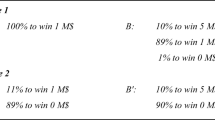Abstract
Using an experimental design of stating equivalent probabilities for 252 stimulus lottery pairs, Chechile and Cooke (1997) alleged to have refuted generic-utility theory which itself comprises many modern utility theories. The present paper systematically investigates the feasibility of the Chechile-Cooke experimental design using numerical methods. We examine 1,277 utility setups (involving 17 parameter sets for four probability-weighting functions and 11 parameter sets for three component utility functions) which represent ten different utility theories. Our results demonstrate that on average for more than one third of all stimulus lottery pairs no equivalent probabilities exist. That is, the Chechile-Cooke experimental design prevents subjects from stating their true probability equivalents. Therefore, they cannot claim to have refuted generic-utility theory and the members of its family.
Similar content being viewed by others
References
Becker, G. M., DeGroot, M.H., and Marschak, J. (1964): “Measuring Utility by a Single-Response Sequential Method.”Behavioral Science 9: 226–232.
Chechile, R. A., and Cooke, A. D. J. (1997): “An Experimental Test of a Generic Class of Utility Models: Evidence for Context Dependency.”Journal of Risk and Uncertainty 14: 75–93.
Chechile, R. A., and Luce, R. D. (1999): “Reanalysis of the Chechile-Cooke Experiment: Correcting for Mismatched Gambles.”Journal of Risk and Uncertainty 18: 321–325.
Edwards, W. (1962): “Subjective Probabilities Inferred from Decisions.”Psychological Review 69: 109–135.
Falmagne, J. C. (1976): “Random Conjoint Measurement and Loudness Summation.”Psychological Review 83: 65–79.
Galanter, E. (1990): “Utility Functions for Nonmonetary Events.”American Journal of Psychology 103: 449–470.
Gigerenzer, G., and Strube, G. (1983): “Are there Limits to Binaural Additivity of Loudness?”Journal of Experimental Psychology: Human Perception & Performance 9: 126–136.
Handa, J. (1977): “Risk, Probabilities, and a New Theory of Cardinal Utility.”Journal of Political Economy 85: 97–122.
Kahneman, D., and Tversky, A. (1979): “Prospect Theory: an Analysis of Decision Under Risk.”Econometrica 47: 263–291.
Karmarkar, U. S. (1978): “Subjectively Weighted Utility: a Descriptive Extension of the Expected Utility Model.”Organizational Behavior and Human Performance 21: 61–72.
Krantz, D. H., Luce, R. D., Suppes, P., and Tversky, A. (1971):Foundations of Measurement, vol. I:Additive and Polynomial Representations. New York: Academic Press.
Luce, R. D. (1988): “Rank-Dependent, Subjective Expected-Utility Representations.”Journal of Risk and Uncertainty 1: 305–332.
— (1990): “Rational Versus Plausible Accounting Equivalences in Preference Judgments.”Psychological Science 1: 225–234.
— (1992): “Where Does Subjective Expected Utility Fail Descriptively?”Journal of Risk and Uncertainty 5: 5–27.
— (1990): “Binary Gambles of a Gain and a Loss: an Understudied Domain.” InMathematical Utility Theory. Utility Functions, Models, and Applications in the Social Sciences, edited by G. Herden, N. Knoche, C. Seidl, and W. Trockel (Journal of Economics/Zeitschrift für Nationalökonomie, Supplementum 8). Vienna: Springer.
Luce, R. D., and Fishburn, P. C. (1991): “Rank-and Sign-Dependent Linear Utility Models for Finite First-Order Gambles.”Journal of Risk and Uncertainty 4: 29–59.
— (1995): “A Note on Deriving Rank-Dependent Utility Using Additive Joint Receipts.”Journal of Risk and Uncertainty 11: 5–16.
Luce, R. D., and Narens, L. (1985): “Classification of Concatenation Measurement Structures According to Scale Type.”Journal of Mathematical Psychology 29: 1–72.
Miyamoto, J. M. (1988): “Generic Utility Theory: Measurement Foundations and Applications in Multiattribute Utility Theory.”Journal of Mathematical Psychology 32: 357–404.
Neumann, J. von, and Morgenstern, O. (1947):Theory of Games and Economic Behavior, 2nd ed. Princeton: Princeton University Press.
Röell, A. (1987): “Risk Aversion in Quiggin and Yaari's Rank-Order Model of Choice under Uncertainty.”Economic Journal 97: 143–159.
Seidl, C. (2000): “Experimental and Empirical Research on Utility II: Utility under Risk.” InHandbook of Utility Theory, vol. II, edited by S. Barberà, P. J. Hammond, and C. Seidl. Boston: Kluwer (forthcoming).
Tversky, A. (1967): “Additivity, Utility, and Subjective Probability.”Journal of Mathematical Psychology 4: 175–201.
Tversky, A., and Kahneman, D. (1992): “Advances in Prospect Theory: Cumulative Representations of Uncertainty.”Journal of Risk and Uncertainty 5: 297–323.
Yaari, M. E. (1987): “The Dual Theory of Choice under Risk.”Econometrica 55: 95–115.
Author information
Authors and Affiliations
Additional information
This paper was submitted to theJournal of Risk and Uncertainty on January 14, 1999. It was, however, rejected on April 16, 1999.
Rights and permissions
About this article
Cite this article
Traub, S., Seidl, C., Schmidt, U. et al. Knock-out for descriptive utility or experimental-design error?. Journal of Economics Zeitschrift für Nationalökonomie 70, 109–126 (1999). https://doi.org/10.1007/BF01224765
Received:
Revised:
Issue Date:
DOI: https://doi.org/10.1007/BF01224765




